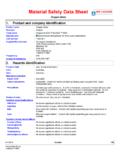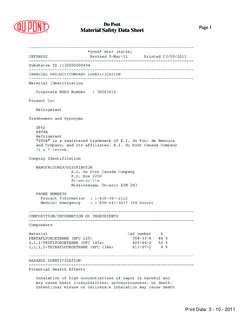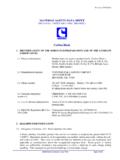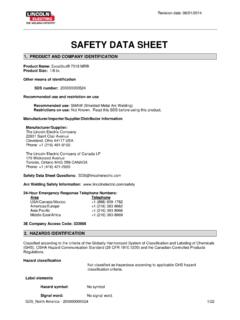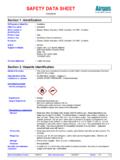Transcription of MATERIAL SAFETY DATA SHEET ER70S-6 …
1 MATERIAL SAFETY data SHEET This MATERIAL SAFETY data SHEET (MSDS) complies with the requirements of OSHA s Hazard Communication Standard. ER70S-6 welding WIRE Emergency Phone Number: 1-866-272-4378 Date: May-05-2011 Product Information Number: 575-874-9188 SECTION 1 PRODUCT IDENTIFICATION Product Name/Class AWS , ER70S-6 welding Wire Product Number ER70S-6 Manufacturer Archer Company USA, Inc. 1665 Futurity Dr., Sunland Park, NM 88063 SECTION 2 HAZARDOUS INGREDIENTS MATERIAL CAS Number % By Weight ACGIH TLV SARA Section 313 Carbon 1333-86-4 <.50 MG/M3 Carbon N/A Manganese 7439-96-5 < C 5MG/M3 Mn & Mn Yes Silicon 7440-21-3 < 10 MG/M3 Total N/A Copper 7440-50-8 <.
2 50 .2 MG/M3 Yes Molybdenum 7439-98-7 <.75 5 MG/M3 N/A Aluminum 7429-90-5 <.50 15 MG/M3 as Weld Yes Titanium 7440-32-6 <.50 10 MG/M3 TiO AS N/A Zirconium 7440-67-7 <.50 5 MG/M3 AS Zr N/A Iron 7439-89-6 Balance 5 MG/M3 Fe203 Fe N/A SECTION 3 PHYSICAL CHARACTERISTICS Boiling Point:N/A Specific Gravity (H2O = 1): N/A Solubility in Water: N/A Vapor Pressure (mm Hg): N/A Melting Point: N/A %Volatile: N/A Vapor Density (Air = 1): N/A Evaporation Rate (Butyl Acetate=1): N/A Appearance and Odor: Solid Wire or Rod.
3 SECTION 4 FIRE and EXPLOSION HAZARD data LEL: N/A Flash Point (Method Used): N/A Flammable Limits: UEL: N/A Extinguishing Media: N/A Special Fire Fighting Procedures: Non Flammable. welding arc and sparks can ignite combustibles and flammables. Refer to American National Standard for fire prevention during the use of welding and allied procedures. Unusual Fire and Explosion Hazards: N/A SECTION 5 REACTIVITY data Unstable Stability Stable Conditions to Avoid: N/A Incompatibility (Materials to Avoid): None Hazardous Decomposition or Byproducts: The composition and quality of welding fumes and gases are dependent upon metal being welded, process, and electrode being used. Other factors include coatings on the metal being welded (paint, plating or galvanizing), number of welders and volume of work area as presence of contaminants in atmosphere. When electrode is consumed fume and gas decomposition products generated are different in percent and form from ingredients listed in Section 2.
4 Fume and gas decomposition products, and not ingredients in electrode, are important. The concentration of given fume or gas component may decrease or increase by many times original concentration in electrode. New compounds not in electrode may form decomposition products of normal operation include those originating from volatilization, reaction, oxidation of materials in Section 2, plus those from base metal and coating. Reasonably expected fume constituents of product could include primarily oxides of iron; secondarily complex oxides of manganese & silicon & aluminum. Gaseous reaction products carbon monoxide, carbon dioxide. Ozone and nitrogen oxides may be formed by radiation from arc, and shielding gases when employed. One recommended way to determine composition and quantity of fumes and gases to which workers are exposed is to take air sample from inside welders helmet or in working zone. See AWS and AWS , available from American welding Society.
5 See AWS publication: Fumes and Gases in the welding Environment . May Occur Hazardous Polymerization Will Not Occur Conditions to Avoid: N/A SECTION 6 HEALTH HAZARD data Carcinogenicity: The composition of welding or brazing fumes may contain carcinogens, depending on several factors that are unknown and unknowable to the product manufacturer (see Section 5). Always assume that welding or brazing fumes may contain toxic and/or carcinogenic materials, and follow sound Work/Hygiene practices as recommended by ANSI Threshold Limit Value: The ACGIH recommended general limit for welding Fume NOC (Not otherwise Classified) is 5 mg/m3. ACGIH-1987-88 preface states that the TLV-TWA should be used as guides in the control of health hazards and should not be used as fine lines between safe and dangerous concentrations. See Section 5 for specific fume constituents which may modify this TLV. Threshold Limit Values are figures published by the American Conference of Government Industrial Hygienists.
6 Units are milligrams per cubic meter of air. Effects of Overexposure: Electric arc welding may create one or more of the following health hazards: Fumes and Gases can be dangerous to your health. Common entry is by inhalation. Other possible routes are skin contact and ingestion. Short-term (acute) overexposure to welding fumes may result in discomfort such as metal fume fever, dizziness, nausea, or dryness or irritation of nose, throat, or eyes. May aggravate pre-existing respiratory problems ( asthma, emphysema). Exposure to extremely high levels of fluorides can cause abdominal pain, diarrhea, muscular weakness, and convulsions. In extreme cases it can cause loss of consciousness and death. Long-term (chronic) overexposure to welding fumes can lead to siderosis (iron deposits in lung) and may affect pulmonary function. Manganese overexposure can affect the central nervous system, resulting in impaired speech and movement.
7 Bronchitis and some lung fibrosis have been reported. Repeated exposure to fluorides may cause excessive calcification of the bone and calcification of ligaments of the ribs, pelvis and spinal column. May cause skin rash. Arc Rays can injure eyes and burn skin. Skin cancer has been reported. Electric Shock can kill. If welding must be performed in damp locations or with wet clothing, on metal structures or when in cramped positions such as sitting, kneeling or lying, if there is a high risk of unavoidable or accidental contact with workpiece, use the following equipment: Semiautomatic DC Welder, DC Manual (Stick) Welder, or AC Welder with Reduced Voltage Control. Emergency and First Aid Procedures: Call for medical aid. Employ first aid techniques recommended by the American Red Cross. IF BREATHING IS DIFFICULT give oxygen. IF NOT BREATHING employ CPR (Cardiopulmonary Resuscitation) techniques. IN CASE OF ELECTRICAL SHOCK, turn off power and follow recommended treatment.
8 In all cases, call a physician. HMIS Rating Health = 2 Flammability = 0 Reactivity = 0 HMIS Scale 4 = Severe Hazard 3 = Serious Hazard 2 = Moderate Hazard 1 = Slight Hazard 0 = Minimal Hazard NFPA Rating Health = 1 Flammability = 0 Reactivity = 0 Other = 0 NFPA Scale 4 = Severe Hazard 3 = Serious Hazard 2 = Moderate Hazard 1 = Slight Hazard 0 = Minimal Hazard SECTION 7 PRECAUTIONS for SAFE HANDLING and USE Steps to Be Taken in Case MATERIAL Is Released or Spilled: N/A Waste Disposal Method: Prevent waste from contaminating surrounding environment. Discard product residue, disposable container or liner in an environmentally acceptable manner, in full compliance with federal, state, and local regulations. Precautions to Be Taken In Handling and Storing: N/A Other Precautions: N/A SECTION 8 CONTROL MEASURES Respiratory Protection (Specify Type): Make sure inhaled air does not contain fume constituents above permissible exposure levels.
9 Ventilation: Use enough ventilation, local exhaust at the arc, or both to keep the fumes and gases from the worker s breathing zone and the general area. Train the welder to keep his head out of the fumes. Keep exposure as low as possible. Protective Gloves: Leather welding gloves. Eye Protection: SAFETY glasses with shaded lenses. Other Protective Clothing or Equipment: Wear hand, head, and body protection which help to prevent injury from radiation, sparks and electrical shock or burns. See At a minimum this includes welder s gloves and a protective face shield or goggles, and may include arm protectors, aprons, hats, shoulder protection, as well as heat-resistant clothing. Work/Hygienic Practices: For maximum SAFETY : Be certified for, and wear a respirator at all times when welding or brazing. OTHER INFORMATION REQUIRED BY STATE OR FEDERAL LAW California Proposition 65 Information: Warning: This product contains a chemical known to the State of California to cause cancer.
10 New Jersey Right-To-Know Information: 5 most predominant ingredients/hazardous and non-hazardous) 1. Iron; 2. Manganese; 3. Silicon; 4. Molybdenum; 5. Copper. SARA Title III Notification Information: All chemical compounds marked with an asterisk (*) are toxic chemicals subject to the reporting requirements of Section 313 of Title III of the Super Fund Amendments and Reauthorization Act (SARA) of 1986 and 40 CFR Part 372. Disclaimer of Expressed and Implied Warranties: The information in this document is believed to be correct as of the date issued. However, no warranty of merchantability, fitness for any particular purpose, or any other warranty is expressed or is to be implied regarding the accuracy or completeness of this information, the results to be obtained from the use of this information or the product, the SAFETY of this product, or the hazards related to its use.

